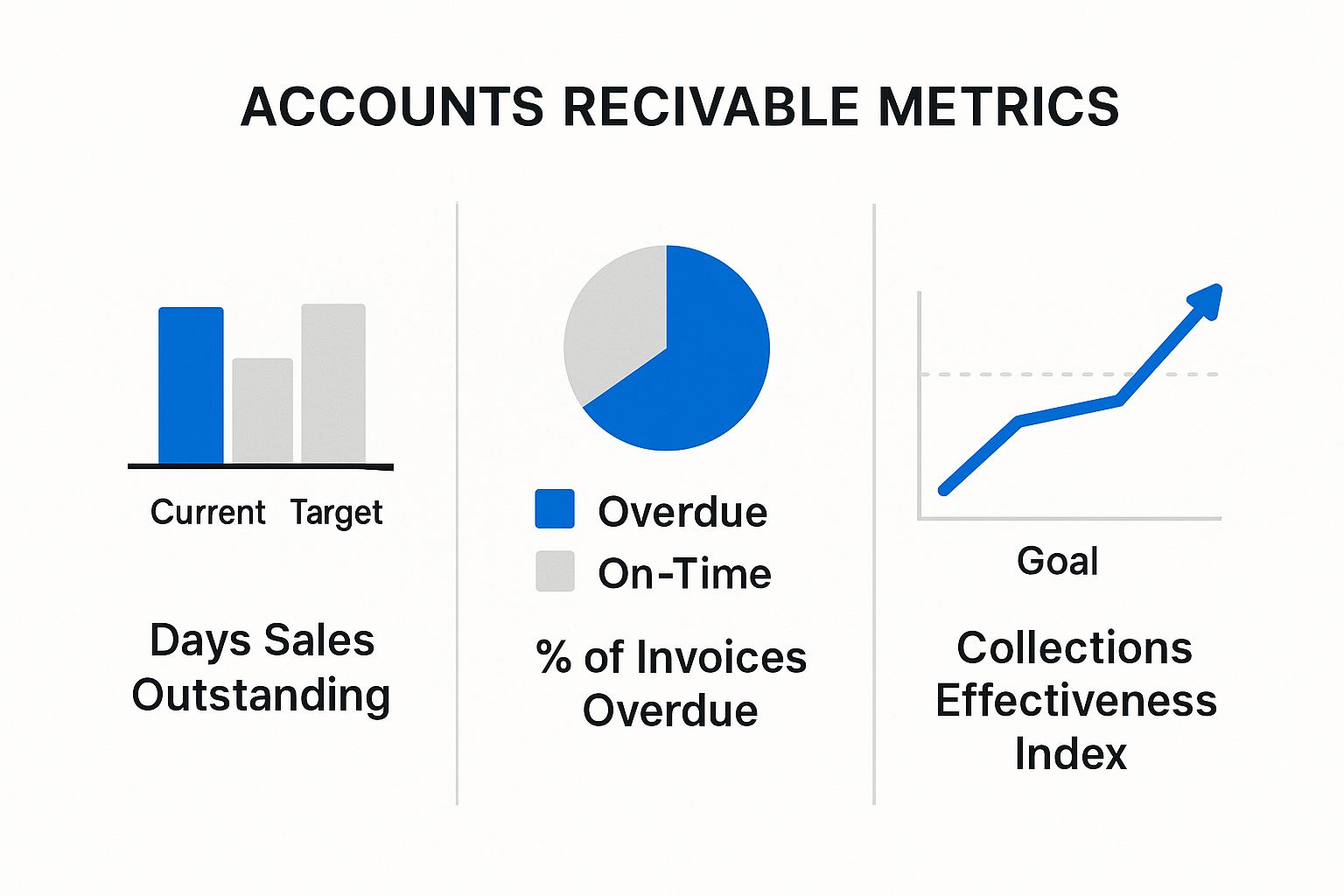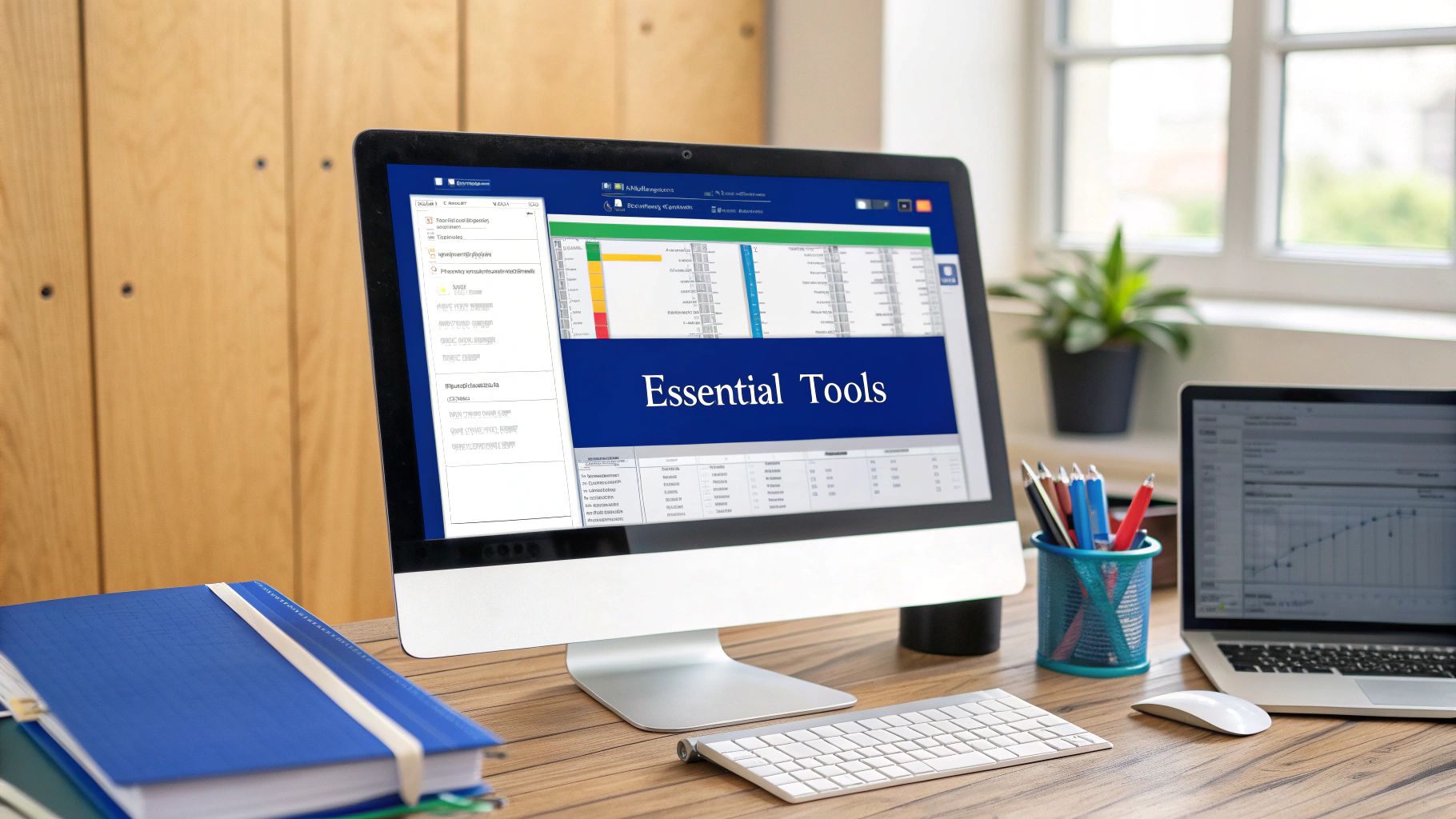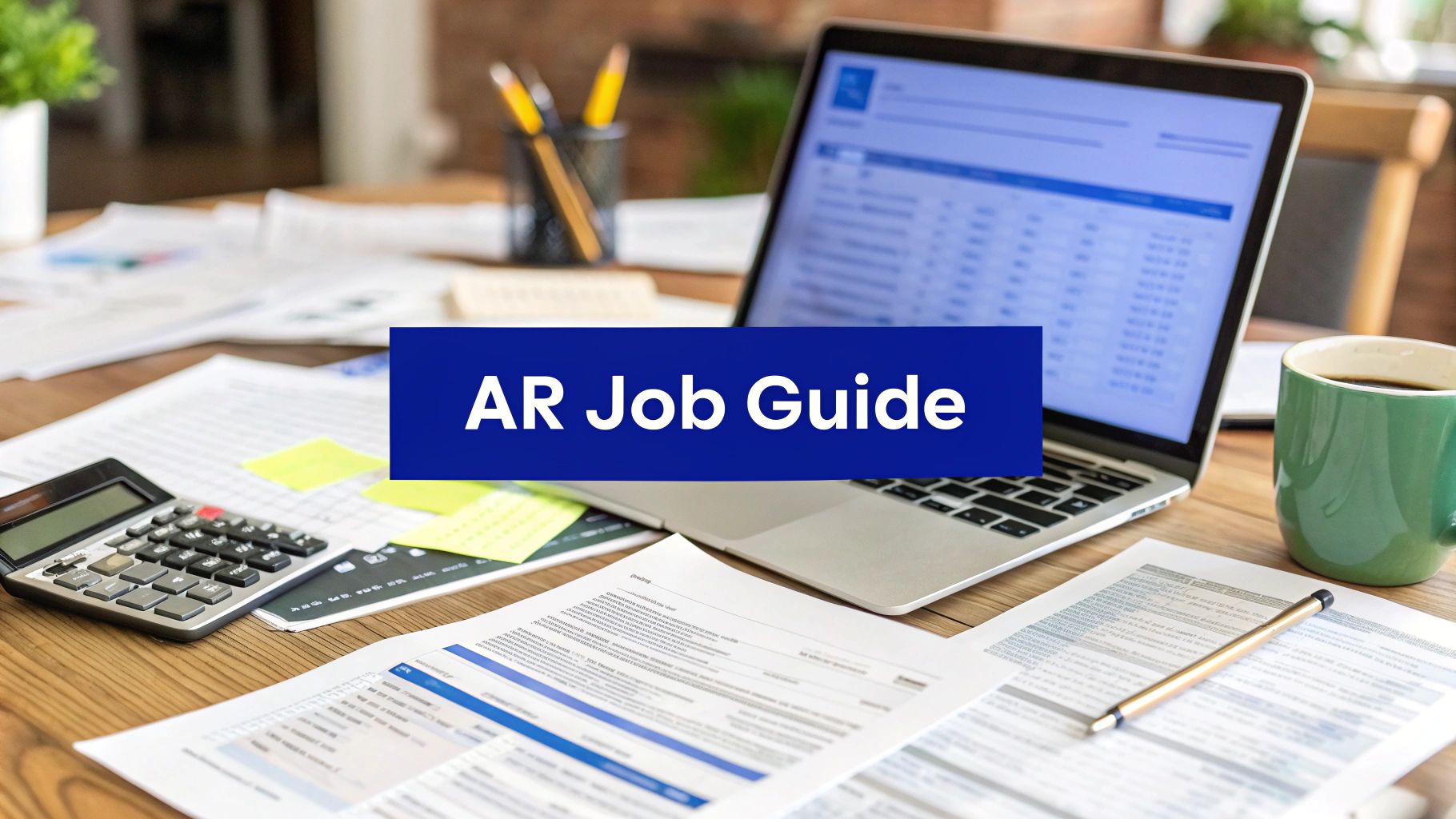Let's be honest, a generic accounts receivable job description is a missed opportunity. If you want to attract high-calibre professionals in a tight market, you need to do more than just list tasks. You need a description that sells the opportunity—one that showcases the role's real value to your company’s financial health, client relationships, and bigger strategic goals. This guide will show you how.
Why Your AR Job Description Is Your Secret Weapon for Attracting Top Talent

Too many businesses treat the accounts receivable job description as a simple administrative checklist. This approach usually brings in candidates looking for a purely transactional job, not the strategic partners who can actively improve your cash flow. The right person in this seat does far more than chase payments; they are the guardians of your company's most critical asset: its incoming revenue.
Think about it. They build relationships with clients, negotiate payment terms, and provide the kind of insights that sharpen your financial forecasting. In a tough economic climate, their ability to manage collections effectively can mean the difference between financial stability and a constant struggle for working capital. The current reality of the UK market really drives this point home.
The Challenge of Late Payments
Late payments are a massive headache for UK businesses. Right now, an estimated 58% of B2B invoiced sales are paid late, with payment terms often stretching to an average of 52 days. This climate makes an effective AR professional absolutely indispensable.
A well-crafted job description doesn't shy away from these challenges; it frames the role as the solution. It’s the difference between saying "process invoices" and "develop strategies to reduce payment delays." That simple shift in language attracts proactive problem-solvers who want to make a tangible impact.
A great job description tells a story, presenting the position as a cornerstone of your financial operations. When you get this right, you attract candidates who see the bigger picture and are genuinely eager to contribute to your company's success. This approach doesn't just secure better talent—it sets the stage for stronger performance and longevity. Investing in your hiring process is a key first step, and our guide on how to improve employee retention offers more insights on keeping those top performers once they're on your team.
At its core, a successful hiring process for an Accounts Receivable role relies on understanding the best practices for writing a job description that actually attracts top talent. This means showcasing the role's importance and the value it brings to the business.
Right, let’s move past the generic, copy-and-paste lists of duties. If you want to attract someone who will genuinely care for your company’s financial health, you need to show them how they'll make a real impact. This part of the job description is where you connect their daily tasks to the lifeblood of the business: its cash flow.
Think about it. You're not just looking for someone to "process invoices." You're looking for someone to safeguard your revenue. So, instead of using passive language, switch to strong, action-oriented verbs that scream ownership.
For example, "Handles collections" is dull and uninspiring. Try this instead: "Drives collections activities by proactively engaging with customers to resolve overdue accounts." See the difference? One is a chore; the other is a challenge. This subtle shift helps a candidate truly visualise themselves in the role, making a tangible difference.
Matching Responsibilities to the Role’s Seniority
It sounds obvious, but you’d be surprised how often this is missed: the duties you list must match the job's level. The day-to-day work of an AR clerk is worlds away from the strategic oversight of an AR manager. Getting this right from the start weeds out mismatched applicants and shows you’ve put real thought into the role’s place within your team.
What an Accounts Receivable Clerk Actually Does:
- Generate and send out accurate customer invoices on schedule.
- Post and apply customer payments to the correct accounts without delay.
- Keep an eye on customer accounts, sending out friendly reminders for upcoming and overdue payments.
- Keep meticulous records of all transactions and conversations with customers.
What an Accounts Receivable Manager Should Be Doing:
- Develop and execute collection strategies to bring down Days Sales Outstanding (DSO).
- Dig into accounts receivable aging reports to spot trends and flag potential credit risks.
- Lead and mentor the AR team, setting clear performance goals and providing coaching.
- Work alongside the sales team and senior leadership to untangle complex billing disputes and streamline the entire order-to-cash process.
This clarity helps candidates self-select. They'll know immediately if the role is a good fit for their skills and career ambitions.
Linking Daily Tasks to Company Goals
The best people don't just want a job; they want to know their work matters. This is your chance to show them how their efforts contribute to the bigger picture. When you frame responsibilities in terms of business outcomes, the role suddenly becomes much more compelling.
A great accounts receivable job description doesn't just list what needs to be done; it explains why it needs to be done. When a candidate sees that their diligence directly impacts the company's ability to fund new projects or grow the team, the position transforms from a simple job into a meaningful career move.
Take customer credit, for instance. It's not just about picking a number out of thin air. It’s a critical risk management function.
- Instead of: "Set credit limits for new customers."
- Try: "Evaluate customer creditworthiness to set appropriate credit limits, mitigating financial risk and protecting company assets."
The same goes for reconciliation. It’s more than just ticking and tying.
- Instead of: "Reconcile the accounts receivable ledger."
- Try: "Perform monthly reconciliations of the AR ledger to guarantee the integrity of financial reporting and support a smooth month-end close."
Using this kind of specific, impactful language turns your job description from a simple advert into a powerful recruitment tool. You'll attract people who are ready to take ownership and deliver real results.
Pinpointing Essential Skills and Qualifications

Once you’ve mapped out the day-to-day responsibilities, it's time to zero in on the skills and qualifications a candidate actually needs. This is a common stumbling block. Many job descriptions either end up too vague or become an intimidating wish list that puts off excellent candidates before they even apply.
The secret is to get really clear about what's essential versus what's simply a bonus.
A great starting point is to split your requirements into two clear lists: "must-haves" and "nice-to-haves." This simple act of prioritising tells candidates you've thought realistically about the position. It also broadens your applicant pool, encouraging talented people who might not tick every single box but have the core abilities to thrive in the role.
Differentiating Technical And Soft Skills
A truly effective accounts receivable job description gives equal weight to technical know-how and interpersonal skills. While proficiency with software is crucial, it’s the soft skills that often make the difference between an average performer and a genuine star.
Technical Skills (The "Must-Haves")
This is the bedrock of the role. Be specific to avoid wasting everyone's time.
- Proficiency in accounting software: Don't just say "accounting software." Name the system you use. If you use Sage 50, state it. If you’re flexible, you could phrase it as, "Experience with accounting software (e.g., Xero, QuickBooks, Sage) is essential."
- Strong MS Excel skills: Go beyond the basics. If you need someone who can analyse data, ask for experience with pivot tables and VLOOKUPs. This signals you’re looking for someone with stronger analytical chops.
- Understanding of basic accounting principles: This is a non-negotiable. Anyone managing your financial records must have a solid grasp of the fundamentals.
To show you’re a modern, efficient business, it’s also a good idea to mention experience with accounting automation tools. This indicates that you value forward-thinking approaches to finance.
Soft Skills (The Deal-Breakers)
These are the skills that directly impact your client relationships and your bottom line.
- Proactive Communication: The role requires someone who can talk to clients about sensitive topics like overdue payments with clarity and professionalism.
- Negotiation and Problem-Solving: The best AR professionals can handle payment disputes and work with clients to find solutions that work for everyone.
- Attention to Detail: It’s a classic for a reason. Accuracy in invoicing, payment application, and reporting is paramount.
The best AR professionals are not just number-crunchers; they are skilled communicators and negotiators. Their ability to maintain positive client relationships while ensuring timely payments is a delicate art that directly protects your cash flow.
Setting Realistic Qualifications
In the UK, formal qualifications are a great benchmark, but they shouldn't be your only measure. You might specify an AAT (Association of Accounting Technicians) qualification, but always add "or equivalent experience" to avoid screening out highly capable candidates who took a different path. For a deeper dive, our guide on the various qualifications for bookkeeping roles can offer more insight.
Finally, a great candidate will understand the wider business environment. For example, recent Bank of England data showed that UK households increased their deposits by £7.4 billion in a single month, a clear sign of a cautious financial climate. A person who understands what this means for cash flow and customer payments is exactly who you want on your team.
Using Performance Metrics to Attract Achievers
Top-tier candidates aren't just scanning for a list of duties; they're looking for a challenge. They want to see exactly how their success will be measured. When you build your accounts receivable job description around clear performance metrics, you're sending a powerful signal to ambitious, results-focused professionals who want to make a real impact.
Think about it. Instead of just listing passive responsibilities, you can frame the role around tangible outcomes. This simple shift changes the entire feel of the job description, elevating it from a standard administrative post to a genuinely strategic position. A great candidate wants to see a problem they can solve and a scoreboard they can influence.
For instance, "manage collections" is vague and uninspiring. A far better approach is: "Take the lead on initiatives to reduce our Days Sales Outstanding (DSO) and improve our Collection Effectiveness Index (CEI)." This small tweak immediately shows you're after a problem-solver, not just a task-doer.
From Tasks to Targets
To really catch the eye of the best talent, you need to connect the role’s day-to-day responsibilities directly to key performance indicators (KPIs). Doing so proves you have a sophisticated approach to financial management and that the successful candidate's work will be valued and measured in a meaningful way.
Here’s how you can reframe some typical duties:
Instead of: "Follow up on overdue invoices."
Try: "Proactively manage an aged debt portfolio to consistently maintain over-90-day balances below 5% of total receivables."
Instead of: "Handle customer billing queries."
Try: "Resolve customer disputes within a 48-hour target window, strengthening client relationships and preventing payment delays."
Incorporating specific, measurable targets like these is a game-changer. If you're unsure which metrics fit best, our guide on selecting the right employee performance metrics can help you define what success looks like across your organisation.
By framing the role around metrics, you are speaking the language of achievers. You’re not just offering a job; you’re presenting an opportunity to drive business results, improve financial health, and showcase their skills in a measurable way.
This metric-driven approach is especially critical for UK businesses. With small businesses owed an average of £27,214 in late payments, the efficiency of your AR team is paramount. Including metrics like the AR Turnover Ratio (which shows how many times a company collects its average receivables annually) demonstrates you're serious about financial health. You can learn more about these vital UK accounts receivable performance metrics to decide which ones to feature.
A great job description should set clear expectations from the start. A table can be a fantastic way to differentiate between the core metrics for a junior role and the more strategic KPIs you'd expect a senior professional to influence.
Essential vs. Advanced AR Performance Metrics
Using a mix of these metrics allows you to tailor the role's focus, ensuring you attract someone with the right level of experience and ambition.
Visuals can also help to tell this story. For example, a simple chart can show a candidate exactly what they're walking into—the current state of affairs versus the targets you want them to help you achieve.

Presenting data this way clearly communicates the challenges and opportunities on offer. It's a direct appeal to the kind of professional who gets excited about moving the needle and making a measurable difference.
Writing and Formatting Your Job Post for Success

So, you've mapped out the responsibilities, pinpointed the essential skills, and defined the metrics for success. Now for the final, critical piece of the puzzle: wrapping it all up into a job post that’s simply too good to scroll past.
Think of it this way: a truly effective accounts receivable job description is much more than a dry list of requirements. It’s a sales pitch. The way you present it—its tone, its clarity, its overall feel—can be the deciding factor between attracting top-tier talent and having your ad get lost in the noise of a crowded job board.
The first real connection a candidate makes is with your company summary. This is your moment to make a genuine impression. Don't just state what your company does; tell them who you are. What's the real vibe of the team? What values actually guide your decisions? This small introduction helps someone instantly gauge whether they can picture themselves working with you.
For instance, instead of a stuffy corporate bio, why not show some personality? Try something like: "We’re a close-knit finance team, passionate about helping small businesses thrive. We live by collaboration, transparency, and a healthy dose of humour—especially when we’re tackling month-end reconciliations." It feels human, and that's exactly what you want.
Structuring for Scannability and Clarity
Let's be realistic: candidates spend only a few seconds scanning a job post before they decide if it's worth a proper read. This means your formatting has to do the heavy lifting to grab and hold their attention. Huge walls of text? That's the quickest way to send a great applicant running.
Keep your paragraphs short and punchy. Be generous with white space.
- Use Clear Headings: Guide the reader through the post with engaging headings. Think "A Day in the Life," "What You'll Bring to the Team," or "Why You’ll Love Working With Us."
- Embrace Bullet Points: They are your best friend for listing responsibilities, skills, and perks. They’re incredibly easy to scan and digest.
- Be Bold: Use bold text sparingly but strategically. It's perfect for highlighting essential skills, specific software like Sage 50 or Xero, or crucial responsibilities you don't want them to miss.
This kind of organised, thoughtful structure makes the information accessible. It also sends a clear signal that you respect the candidate's time.
Your job description is a marketing document. Every single element, from the tone of voice to the use of white space, should be designed to engage the reader and sell them on the opportunity to join your company.
Avoiding Common Job Description Mistakes
Even the most perfectly structured post can fall flat if you stumble into a few common traps. Sidestepping these will immediately elevate the quality of your applicant pool.
Jargon and Vague LanguageCut out the internal acronyms and company-specific jargon. An external candidate won’t have a clue what you’re talking about, and it just creates a barrier. Be direct. Instead of "Assist with Q3 financial close," be specific: "Support the team with quarterly financial reporting and reconciliations."
Salary SecrecyIn the UK market especially, failing to include a salary range is a major red flag for many job seekers. It can suggest the compensation is below market rate, and it ends up wasting everyone’s time. Posting a competitive and realistic salary band demonstrates transparency and attracts serious, well-qualified applicants from the start.
Finally, remember your post needs to be easily understood by both people and software. To get your accounts receivable job description in front of the right people, it pays to understand how Applicant Tracking Systems (ATS) work. For more on this, check out this ultimate guide to Applicant Tracking Systems (ATS), which has some great advice on making sure your formatting is system-friendly.
By combining a compelling story with clean, scannable formatting, you’ll create a job post that stands out for all the right reasons.
Answering Your Questions About AR Job Descriptions
When you're putting together an accounts receivable job description, a few questions always seem to pop up. I’ve seen hiring managers puzzle over these same points time and again. Getting them right from the start can be the difference between a flood of irrelevant applications and a shortlist of perfect-fit candidates.
Let’s tackle some of the most common queries I hear from UK businesses.
What Is the Difference Between a Clerk and a Specialist?
This is a classic one. While you might see these titles used interchangeably, there’s a real difference in the scope of the roles. Think of it in terms of execution versus strategy.
An Accounts Receivable Clerk is typically focused on the daily, transactional side of things. Their world revolves around processing invoices, applying payments, and keeping the ledger clean. It's a vital, hands-on role.
On the other hand, an Accounts Receivable Specialist usually brings more experience and analytical thinking to the table. They’re the ones you’d expect to untangle complex account discrepancies, take the lead on tricky dispute resolutions, or even analyse payment data to help refine the entire collections process. Be explicit in your job post about the level of autonomy and strategic input you’re looking for.
- A Clerk's task might be: Generating and sending out 100+ accurate invoices every morning.
- A Specialist's task might be: Analysing payment patterns across key accounts to flag credit risks and suggest new payment terms.
How Important Is It to List a Salary Range?
In the UK, it’s not just important; it’s essential. I’ve seen fantastic job posts get ignored simply because they were coy about the salary. Candidates today are savvy. If they don’t see a salary range, they often assume the pay is below market rate or simply won’t risk wasting their time on a long application process with an unknown reward.
Transparency about salary shows you’re a serious employer who respects a candidate's time. It's one of the quickest ways to align expectations and get applications from people who are genuinely in the right ballpark for the role.
Honestly, it just saves everyone a headache and immediately positions your company as a fair and straightforward place to work.
What Software Skills Are Most In-Demand?
Knowing your way around specific accounting software is non-negotiable for most AR roles. Here in the UK, you’ll find that experience with platforms like Sage (especially Sage 50 and Sage 200), Xero, and QuickBooks is incredibly common. For bigger companies, you'll want to see experience with large-scale ERP systems like SAP, Oracle NetSuite, or Microsoft Dynamics 365.
But don't forget the universal tool: Microsoft Excel. Strong Excel skills are almost always a given for reporting and analysis. Don't just say "proficient in Excel," though. Be specific about what that actually means.
- Essential Excel skills: Mention things like VLOOKUPs, pivot tables, and advanced formulas.
- ERP experience: If you use a specific system, name it. But it's also smart to add something like "or experience with similar enterprise-level systems," so you don't accidentally filter out a great candidate who can get up to speed quickly.
Should I Include Details About Company Culture?
Absolutely, yes. A job description is more than a shopping list of responsibilities; it’s your first sales pitch to a potential new team member. A short, genuine paragraph about your company’s mission, values, and what it’s actually like to work there can make you stand out.
Think about what makes your company a great place to be.
- Is your finance team tight-knit and collaborative?
- Do you offer flexible or hybrid working?
- Are there real opportunities for training and professional growth?
Sharing these details helps a candidate see if they’ll click with your team. It attracts people who aren't just looking for a paycheque but a place where they can settle in, contribute, and build their career. It turns a boring list of duties into a compelling invitation.

